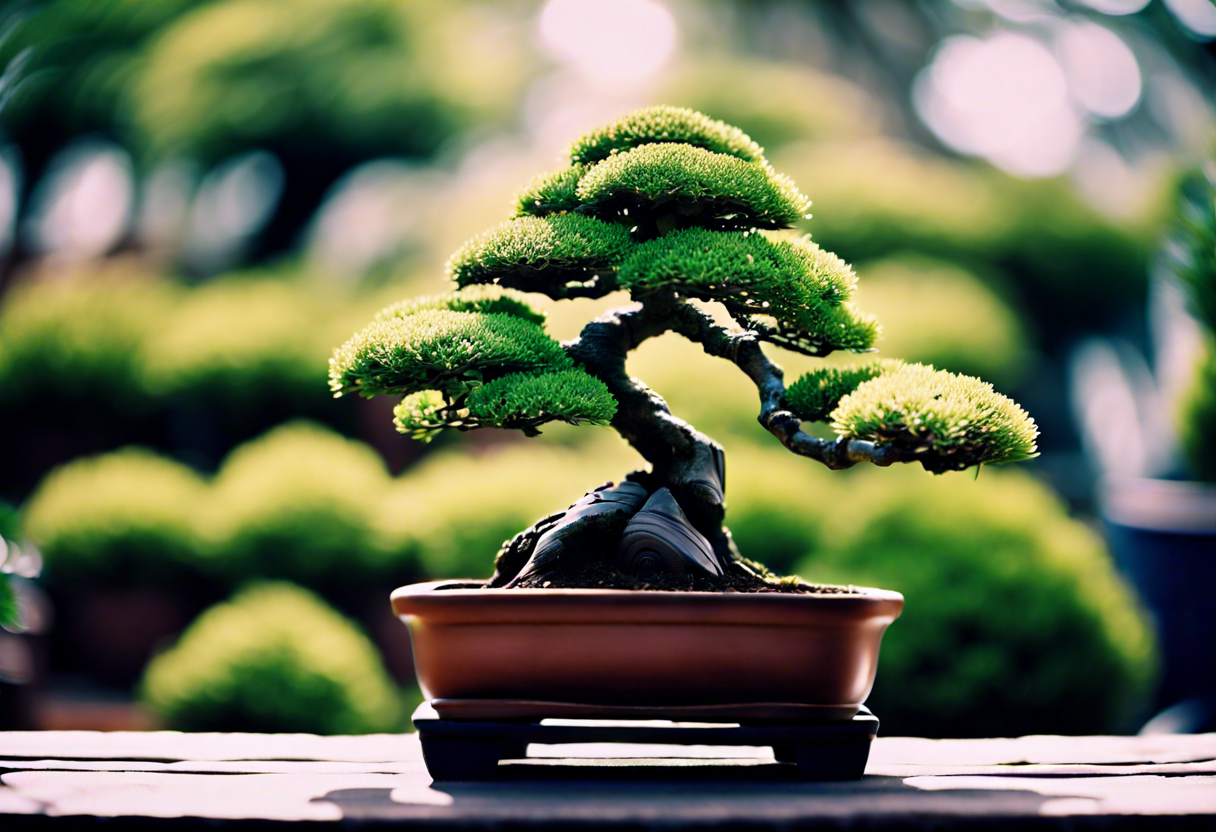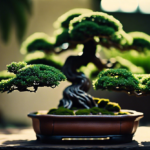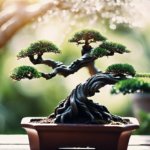Proper Watering Techniques for a Bonsai Tree
When it comes to caring for a bonsai tree, proper watering is crucial for its health and longevity. Overwatering can lead to root rot, while underwatering can result in dehydration and stress for the tree. Finding the right balance is key to maintaining a thriving bonsai.
To determine when to water your bonsai tree, the best method is to check the soil moisture levels. Stick your finger about an inch into the soil; if it feels dry to the touch, it’s time to water. It’s essential to use a watering can with a fine rose attachment to distribute water evenly and gently across the soil surface. This helps prevent soil erosion and ensures that the water reaches the roots effectively.
The frequency of watering a bonsai tree will vary depending on factors such as the tree species, pot size, soil mix, and environmental conditions. For most bonsai trees, a good rule of thumb is to water thoroughly once the soil starts to dry out. However, it’s essential to observe how your specific tree responds to watering and adjust accordingly.
During the growing season, typically spring through fall, bonsai trees tend to require more frequent watering due to increased sunlight and warmer temperatures. In contrast, during the dormant winter months, when growth slows down, less water is generally needed. Adjust your watering schedule accordingly to accommodate these seasonal variations.
Another crucial aspect of proper watering is ensuring adequate drainage for your bonsai tree. Planting your bonsai in a well-draining soil mix and a pot with drainage holes can prevent waterlogging and promote healthy root growth. Avoid letting your bonsai sit in excess water, as this can lead to root suffocation and eventual decline.
Mastering the art of proper watering for your bonsai tree is essential for its overall health and well-being. By paying close attention to your tree’s specific needs and adjusting your watering practices accordingly, you can help your bonsai thrive and flourish for years to come.
For more detailed information on bonsai tree care, you can visit Bonsai Empire for expert tips and resources.
The Importance of Sunlight and Ideal Placement for Bonsai Care
Proper sunlight exposure is crucial for the health and growth of your bonsai tree. As a general rule of thumb, most bonsai tree species thrive in direct sunlight for at least five to six hours a day. However, it’s essential to consider the specific needs of your tree species, as some may require more or less sunlight.
When determining the ideal placement for your bonsai tree, consider placing it in a location where it can receive adequate sunlight without being exposed to harsh, direct sunlight for prolonged periods. East-facing windows are an excellent choice since they provide morning sun, which is less intense and beneficial for the tree’s growth.
It’s imperative to monitor your bonsai tree regularly to ensure it’s receiving the right amount of sunlight. If you notice that the leaves are turning yellow or browning at the edges, it could be a sign of too much sunlight. Conversely, if the leaves are becoming pale or leggy, it may indicate that the tree isn’t receiving enough sunlight.
In addition to sunlight, proper air circulation is also essential for the overall health of your bonsai tree. Avoid placing your tree in drafty areas or near air vents, as this can cause stress to the tree and lead to health issues.
For more information on bonsai care and placement tips, you can visit Bonsai Empire for expert advice and resources.
Pruning and Shaping Tips for Maintaining Bonsai Tree Health
Proper pruning and shaping techniques are crucial for the health and aesthetics of a bonsai tree. Pruning helps control the size and shape of the tree while shaping gives it a distinct appearance. Here are some essential tips to ensure your bonsai tree thrives:
1. Tools for Pruning: Invest in high-quality bonsai tools such as shears, concave cutters, and knob cutters. These tools ensure clean cuts, promoting faster healing and reducing the risk of infections.
2. Pruning Techniques: Regularly prune dead, damaged, or overgrown branches to maintain the tree’s shape and health. Use sharp, clean tools to make precise cuts at a 45-degree angle without leaving stubs.
3. Branch Selection: When deciding which branches to prune, consider the tree’s overall design and health. Remove branches that disrupt the tree’s proportions or hinder its growth.
4. Wiring: Wiring is a technique used to shape bonsai trees by gently wrapping aluminum or copper wires around branches. Be cautious not to wrap the wire too tightly to avoid damaging the bark.
5. Timing: The best time to prune a bonsai tree is during its dormant period in late winter or early spring. Avoid heavy pruning during the growing season as it can stress the tree.
6. Shaping Styles: Explore different shaping styles like formal upright, informal upright, slanting, cascade, and semi-cascade to give your bonsai tree a unique look. Research and practice to master various shaping techniques.
7. Healing and Maintenance: After pruning, monitor the tree for any signs of stress or infection. Apply a healing paste or cut paste on larger cuts to promote quicker healing and prevent diseases.
Mastering pruning and shaping techniques is essential for maintaining the health and beauty of your bonsai tree. Regular practice, attention to detail, and patience are key to developing stunning bonsai designs that reflect your creativity and dedication. For more in-depth guidance on bonsai pruning and shaping, visit Bonsai Empire. Take the time to learn and refine your skills to create captivating bonsai creations that stand the test of time.
Fertilizing Schedules and Best Practices for Bonsai Tree Growth
Fertilizing plays a crucial role in the growth and overall health of bonsai trees. Unlike standard plants, bonsai trees are grown in small containers, which limits their access to essential nutrients. Therefore, it is vital to provide them with regular fertilization to ensure they thrive and maintain their compact size. Here, we will delve into the importance of proper fertilizing schedules and the best practices to promote optimal bonsai tree growth.
Understanding the Basics of Fertilizing Bonsai Trees
Fertilizers are rich in nutrients that bonsai trees require for healthy growth. These nutrients typically include nitrogen (N), phosphorus (P), and potassium (K), along with other essential minerals. When selecting a fertilizer for your bonsai tree, it is crucial to choose a balanced formula specifically designed for bonsai cultivation. A balanced fertilizer with equal proportions of NPK (nitrogen, phosphorus, potassium) helps maintain overall tree health and encourages steady growth.
Creating a Fertilizing Schedule
Establishing a consistent fertilizing schedule is key to promoting the long-term health and vitality of your bonsai tree. During the growing season, typically in spring and summer, bonsai trees are actively growing and require more frequent fertilization. A general rule of thumb is to fertilize your bonsai tree every two weeks, using a diluted solution to prevent root burn.
Best Practices for Fertilizing Bonsai Trees
-
Use the Right Type of Fertilizer: Opt for a water-soluble, balanced fertilizer designed for bonsai trees. Avoid using standard garden fertilizers, as they may contain high levels of nutrients that can harm your bonsai.
-
Follow Dosage Instructions: Always follow the instructions provided on the fertilizer packaging. Over-fertilizing can lead to nutrient build-up in the soil, damaging the roots of your bonsai tree.
-
Adjust Fertilizer Frequency: During the dormant winter months, reduce fertilization to once a month or based on the specific needs of your bonsai tree species.
-
Consider Organic Fertilizers: Organic fertilizers are gentle on bonsai trees and provide a slow release of nutrients over time. They promote overall soil health and microbial activity.
By adhering to a regular fertilizing schedule and implementing best practices, you can ensure your bonsai tree receives the essential nutrients it needs to flourish. Remember to observe your tree regularly to adjust the fertilizing regimen based on its individual requirements.
For more in-depth information on fertilizing bonsai trees, visit Bonsai Empire’s Fertilizer Guide for expert insights and recommendations.
Common Pests and Diseases Affecting Bonsai Trees and How to Manage Them
Bonsai trees are susceptible to various pests and diseases that can affect their health and overall appearance. It is essential for bonsai enthusiasts to be vigilant and proactive in identifying and managing these common issues to ensure the well-being of their cherished plants.
One of the most common pests that can afflict bonsai trees is the Spider Mite. These tiny arachnids suck the sap from the leaves of the tree, causing discoloration and stunted growth. To prevent and manage Spider Mite infestations, regular inspection of the tree is crucial. If an infestation is detected, spraying the tree with a gentle insecticidal soap can help control the population.
Another common issue that bonsai trees face is fungal diseases such as Powdery Mildew and Root Rot. Powdery Mildew presents as a white powdery substance on the leaves, while Root Rot causes the roots of the tree to decay due to overwatering or poor drainage. To combat these diseases, it is important to ensure proper airflow around the tree and avoid overwatering. Applying a fungicidal spray can also help prevent the spread of fungal infections.
Aphids are another nuisance that can damage bonsai trees by feeding on the sap of the leaves and excreting a sticky substance that attracts mold. Regularly inspecting the undersides of leaves for clusters of aphids and spraying the tree with neem oil or insecticidal soap can help keep these pests at bay.
Scale insects are also a common problem for bonsai trees, appearing as small, waxy bumps on the branches and stems. To manage scale infestations, gently scrubbing the affected areas with a soft brush dipped in soapy water can help remove these stubborn pests.
In addition to pests, bonsai trees can also be affected by nutrient deficiencies, which can manifest as yellowing leaves or stunted growth. Regularly fertilizing the tree with a balanced bonsai fertilizer and ensuring it receives adequate sunlight can help prevent nutrient deficiencies and promote healthy growth.
Maintaining the health of a bonsai tree requires diligence and care in identifying and managing common pests and diseases. By being proactive and following proper bonsai care practices, enthusiasts can enjoy their beautiful miniature trees for years to come.
For further information on managing pests and diseases affecting bonsai trees, you can refer to Bonsai Empire.
Conclusion
To ensure the health and vitality of your bonsai tree, it is crucial to master the art of proper watering techniques. Overwatering can lead to root rot, while underwatering can stress the tree. Finding the right balance by checking the soil moisture regularly and adjusting your watering routine accordingly is key to the tree’s overall well-being.
In addition to watering, sunlight plays a vital role in the growth and development of bonsai trees. Understanding the light requirements of your specific tree species is essential. Providing adequate sunlight and ensuring the bonsai is placed in an ideal location where it can receive the right amount of light will promote healthy growth and vibrant foliage.
Pruning and shaping are essential aspects of bonsai tree care. Regular maintenance through strategic pruning not only helps maintain the desired shape and size of the tree but also enhances branching and foliage density. By following proper pruning techniques and understanding the growth patterns of your bonsai, you can effectively promote overall tree health and aesthetics.
Fertilizing your bonsai tree is another crucial element in its care regimen. Choosing the right type of fertilizer and following a consistent fertilizing schedule will provide essential nutrients for growth and development. Understanding the nutritional needs of your bonsai tree based on its species and growth stage is essential for fostering healthy roots, foliage, and overall vitality.
Despite your best efforts, bonsai trees are susceptible to pests and diseases. Identifying common pests such as aphids, spider mites, or scale insects early on can help prevent infestations and minimize damage. By practicing good hygiene, monitoring your tree regularly, and choosing appropriate treatment methods when needed, you can effectively manage and control pests and diseases that may threaten your bonsai’s health.
Caring for a bonsai tree is a rewarding and enriching experience that requires patience, dedication, and a deep understanding of the tree’s needs. By mastering proper watering techniques, providing adequate sunlight, practicing regular pruning and shaping, following a fertilizing regimen, and staying vigilant against pests and diseases, you can create a thriving and beautiful bonsai tree that will bring you years of joy and satisfaction. Embrace the art of bonsai cultivation, and your efforts will be rewarded with a miniature masterpiece that reflects the beauty and harmony of nature.


